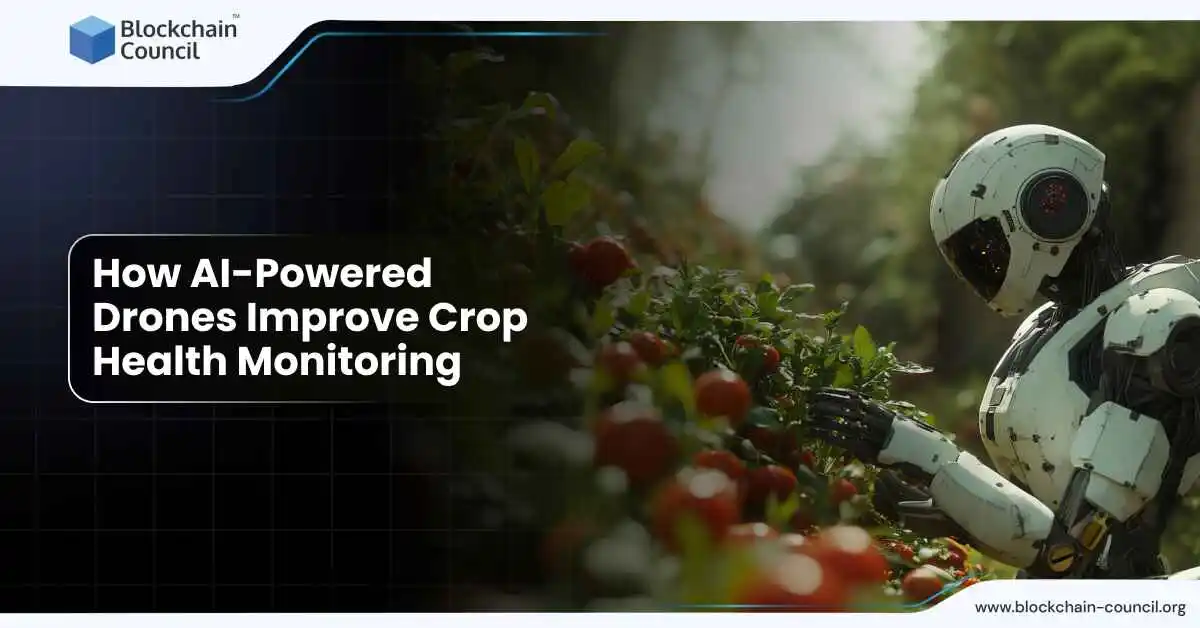
- Blockchain Council
- January 04, 2025
Farmers across the world are already using AI-driven drones for their crops. These technologies allow them to gather detailed, real-time information, which helps in making decisions and boosting harvests.
How Drones Track Crop Health
AI-powered drones rely on various tools like thermal cameras, multispectral imaging, and machine learning to check on crops. They fly over large fields, taking clear images that reveal things the human eye might miss, such as early disease signs, insect problems, or even water stress. AI systems take the gathered data, analyze it, and find issues while offering possible solutions.
These special cameras, which can capture data beyond what humans can see, help reveal slight changes in plant health. For instance, drones can spot differences in plant color or temperature, often pointing to problems like lack of nutrients or fungal issues. When these troubles are caught early, farmers can address them quickly, preventing further damage and leading to healthier plants.
Take California as an example, where farmers use drones to save up to 20% of water. These drones map out moisture levels in vast fields, guiding more targeted irrigation. This leads to healthier crops without wasting water. In this case, the precision offered by AI-powered drones far surpasses what older methods could achieve.
Precision Farming: Less Waste, More Productivity
Data-based farming thrives with the help of precision tools, and AI-powered drones are key to this. The information they gather helps farmers use fertilizers, pesticides, and water more efficiently by targeting only the areas that need it. For example, drones create detailed maps based on the crop’s health, allowing for specific treatments in certain areas, rather than treating the whole field. This approach helps reduce waste and minimizes harmful environmental impacts from farming.
In crop monitoring, drones such as the DJI Mavic 3M, commonly used in farming, provide clear, high-definition images. These images help make detailed maps of orchards or fields. These maps give insights into growth patterns, helping identify spots with uneven growth or areas that might face water issues. Farmers all over the world are seeing the benefits, with improved yields and reduced costs.
Spotting Diseases and Offering Precise Treatments
AI drones are extremely useful in spotting plant diseases early. Traditional methods, like walking through fields to inspect, are time-consuming and may miss early warning signs. AI drones, however, can scan large areas in a short period, capturing detailed images that can then be analyzed for any signs of disease.
Pest control is another area where these drones are helpful. Drones equipped with AI systems can tell the difference between healthy crops, weeds, and pests. This lets farmers only apply pesticides where necessary, reducing the amount of chemicals used. Some farmers have reported using up to 30% less pesticide with this focused approach, making their farming practices much more eco-friendly.
Helping Farmers and Protecting the Environment
Farmers who use AI drones to monitor crop health have noticed many advantages. These drones also save time and effort by inspecting large fields much faster than manual checks. A drone can survey hundreds of acres in less than an hour, a task that would take several days if done manually. For instance, farmers in South America have increased their crop yields by around 15% after incorporating AI drones, while also reducing their pesticide usage by up to 30%, due to the targeted chemical applications.
Beyond saving labor and time, AI drones contribute to more sustainable farming by minimizing waste and optimizing the use of resources. With these drones, farmers can achieve higher productivity with fewer resources, which is vital in a world where resources are increasingly limited, and the demand for sustainable farming is growing.
Obstacles and Future Prospects
While the benefits of AI-powered drones are clear, they aren’t without challenges, especially for smaller farms. However, the initial investment can be high, and operating them requires technical knowledge. Additionally, there are concerns around privacy and security due to the large amount of data collected by the drones.
That being said, improvements in technology are making drones cheaper and easier to use. Governments and other organizations are also providing training and financial help, which is expected to make drones more accessible to a broader range of farmers. As this happens, AI-powered drones will likely play a bigger role in monitoring crop health and making farming practices more efficient.
Final Thoughts
AI-powered drones are changing modern agriculture, offering farmers accurate tools to manage and monitor crop health. By spotting diseases early, improving resource use, and cutting labor costs, these drones are making farming more efficient and sustainable.
As AI and drone technology continue to improve, farmers will increasingly benefit from these tools, ensuring healthier crops, less environmental impact, and improved profitability. The real-world examples of AI-driven drones in action demonstrate how farming is evolving for the betterment of farmers and the environment alike.





































































 Guides
Guides News
News Blockchain
Blockchain Cryptocurrency
& Digital Assets
Cryptocurrency
& Digital Assets Web3
Web3 Metaverse & NFTs
Metaverse & NFTs
